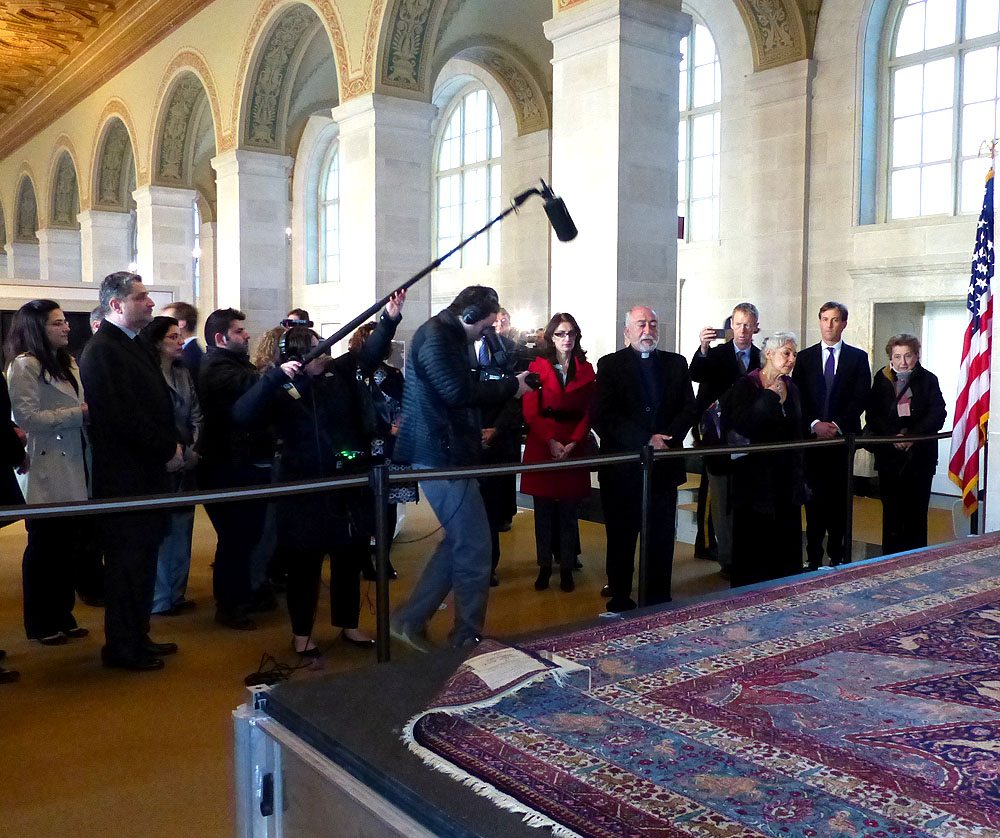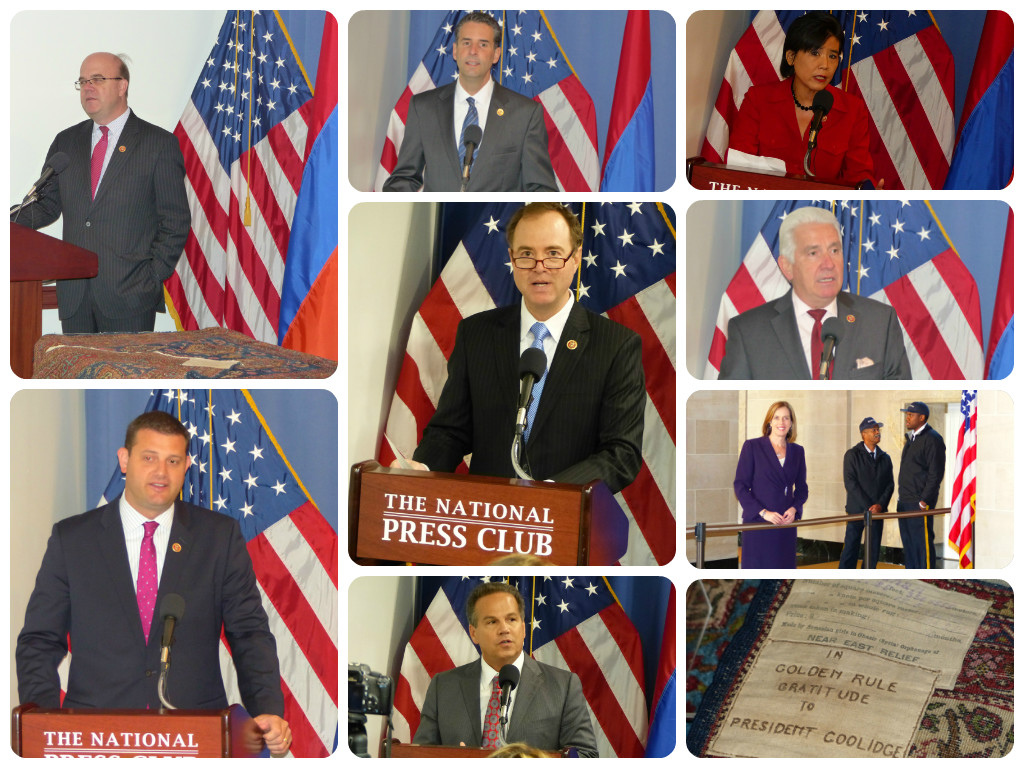Call for End to Ankara’s Gag-Rule against US Reaffirmation of Armenian Genocide
WASHINGTON—Members of Congress joined with Armenian American organizations today in welcoming the display of the White House’s historic Armenian Orphan Rug and in urging the Administration to reject the gag-rule that Turkey has long enforced against honest American discourse about the Armenian Genocide, reported the Armenian National Committee of America (ANCA).

Fr. Sarkis Aktavoukian blesses the Armenian Orphan Rug as Members of Congress and Armenian Community leaders look on.
The Armenian Orphan Rug, woven by child survivors of the Genocide, was gifted to President Coolidge in 1925 in appreciation of U.S. humanitarian assistance.
Representatives Adam Schiff (D-Calif.) and David Valadao (R-Calif.) were joined by fellow colleagues Judy Chu (D-Calif.), David Cicilline (D-R.I.), Katherine Clark (D-Mass.), Jim Costa (D-Calif.), James McGovern (D-Mass.), and John Sarbanes (D-Md.) at the National Press Club for a kick-off press conference, followed by a special blessing by Fr. Sarkis Aktavoukian and viewing of the Armenian Orphan Rug—also known as the Ghazir Rug—at the White House Visitor Center. Author and Armenian Orphan Rug expert, Dr. Martin Deranian; Armenian Rug Society Board of Directors Member Hratch Kozibeyokian; ANCA WR’s “America We Thank You: An Armenian Tribute to Near East Relief” Initiative Member Missak Kelechian; as well as, ANCA Executive Director Aram Hamparian and Armenian Assembly of America Executive Director Bryan Ardouny discussed the significance of the Armenian Orphan Rug in both American and Armenian history.
White House Display “No Substitute” for U.S. Reaffirmation of Armenian Genocide
As Members of Congress celebrated the release of the Armenian Orphan Rug from White House storage, they all referenced the need for formal and unequivocal U.S. reaffirmation of the Armenian Genocide.
“The Ghazir Rug is not just a carpet; it is a tangible connection to the first genocide of the twentieth century—a silent, beautiful rebuttal to those who deny the murder of 1.5 million men, woman and children in a campaign of mass murder, forced marches, rape and looting that befell the Armenian people from 1915-23,” explained Rep. Adam Schiff, who, over the past year, led the effort to secure White House display of the artifact after over 30 years in storage. “As the world prepares to commemorate the centennial of the genocide, the Ghazir Rug brings to life the shattered families and the mass inhumanity that was visited upon the Armenian people. And I hope that it can serve to educate a new generation of Americans about one of the great tragedies of history and leads to a redoubling of efforts in 2015 to finally and forever, honor the genocide of the Armenians without equivocation.”
Central Valley, California’s Rep. David Valadao told press conference attendees “My Congressional District is home to a very large Armenian population that has a very strong presence in our community. The Armenian Orphan Rug is a shared piece of American and Armenian history that should be available to the public. I am excited my colleagues and I were able to help secure a public display of the rug.”

Representatives Schiff and Valadao were joined by colleagues Chu, Cicilline, Clark, Costa, McGovern and Sarbanes at the National Press Club.
Representatives Schiff and Valadao secured the support of over 30 Members of Congress in November, 2013, culminating in a successful year-long campaign to encourage the White House to display the historic treasure.
“The Armenian Orphan Rug symbolizes the enduring Armenian spirit,” said Representative John Sarbanes. “As the world prepares to mark the centennial of the Armenian Genocide, I hope that the display of the Orphan Rug will spark an honest discussion about one of history’s darkest chapters and lead finally to a formal and official recognition of the genocide.”
“The Armenian Orphan Rug exhibit is an opportunity for Americans to see with their own eyes a moving, physical reminder of the Armenian Genocide,” said Rep. Katherine Clark. “It’s an incredible and important milestone for the White House to display its 4 million knots woven by children whose lives were devastated nearly 100 years ago. It’s long overdue for the U.S. to formally recognize the Armenian Genocide.”
“The Armenian Orphan Rug is a shared piece of American and Armenian history that belongs to the American people,” said Rep. Jim Costa (D-Calif.). “Today represents progress, but falls short of the full and formal recognition of the Armenian Genocide, that should be a cornerstone of U.S. human rights policy.”
“This great artifact is both a symbol of the strong relationship between Armenia and the U.S., and a stark reminder about the first genocide of the modern era where 1.5 million Armenians perished at the hands of the Ottoman Empire,” Rep. David Cicilline told attendees. “Together with leaders in the American-Armenian community we successfully worked with the White House to make sure the Armenian Orphan Rug and its historical meaning will be shared with the country.”
“For the last 10 years, the Armenian American community has fought to get this rug released and displayed to the public,” said Rep. Judy Chu. “This is only a first step. This story reinforces why Congress must pass a resolution to recognize the Armenian Genocide.”
“Worcester, Massachusetts is home to one of the oldest Armenian communities in America, and I’m very proud to be here today with George Aghjayan from Worcester and my good friend Dr. Martin Deranian from Shrewsbury, who is the author of such an important book on the Armenian Orphan Rug,” said Rep. McGovern. “While we are all proud and pleased that the Armenian Orphan Rug is being displayed at the White House [Visitors Center] this week, it is no substitute for the President recognizing the Armenian Genocide. The U.S. needs to formally recognize the Armenian Genocide now, before the last survivor is gone.”
White House Display Fails to Characterize Moral and Historic Dimensions of Armenian Orphan Rug
ANCA Executive Director Aram Hamparian, Legislative Affairs Director Raffi Karakashian and ANC Central Massachusetts Chairman George Aghjayan were first in line at the White House Visitor Center to view the Armenian Orphan Rug on the morning of the display opening. Magnificent in its presentation, the accompanying plaque described the genocide survivors who wove the rug only as having been “orphaned during World War I,” with no reference—either directly or indirectly—to the crime that precipitated the overwhelming U.S. outpouring of humanitarian support.
Hamparian explained, “Today’s White House display of the Armenian Orphan Rug is a testament to the generous spirit of the American people, whose unprecedented humanitarian assistance efforts saved hundreds of thousands of survivors of the Armenian Genocide – including the Armenian orphans who meticulously crafted this unique artifact of American and Armenian history. Unfortunately, the display’s description – using evasive and euphemistic language – deprives this profoundly important work of art of its moral and historical meaning. It also deprives viewers of the opportunity to learn about the Armenian Genocide and draw lessons from this experience to prevent future atrocities.”
Hamparian went on to “thank Congressman Schiff and Valadao and all their colleagues who helped make this display possible, and whose efforts are already sparking national and international attention to this still unpunished crime. We remain troubled that on the eve of the Armenian Genocide Centennial, Turkey’s gag rule is still in force and remain committed to a truthful and just international resolution of this crime.”
After long decades in storage, and following Congressional pressure and a nationwide Armenian American grassroots campaign to secure its release, the White House has agreed to the display of the Armenian Orphan Rug, woven by orphan survivors of the Armenian Genocide and gifted to U.S. President Calvin Coolidge in 1925 in appreciation for U.S. humanitarian assistance following Turkey’s mass murder of over 1.5 million Armenians and other Christians.
The White House is displaying the Armenian Orphan Rug as part of an exhibit at the White House Visitors Center. The exhibit—entitled “Thank you to the United States: Three Gifts to Presidents in Gratitude for American Generosity Abroad”—will showcase the Ghazir rug, as well as the Sèvres vase, given to President Herbert Hoover in appreciation for feeding children in post-World War I France, and the Flowering Branches in Lucite, given to President Barack Obama in recognition of American support of the people of Japan after the devastating earthquake and tsunami in 2010. These three gifts to American presidents will be on display so visitors to the White House and those wishing to see the artifacts can view them.”
The exhibit is taking place at the White House Visitor Center from November 18th to 23rd. The White House Visitor Center is located at 1450 Pennsylvania Ave, NW, Washington, DC and is open to the public from 7:30 a.m. to 4 p.m. daily.
The Armenian Orphan Rug measures 11′ 7″ x 18′ 5″ and is comprised of 4,404,206 individual knots. It took Armenian girls in the Ghazir Orphanage of Near East Relief 10 months to weave. The rug was delivered to President Coolidge on December 4, 1925, in time for Christmas, with a label on the back of the rug, which reads “IN GOLDEN RULE GRATITUDE TO PRESIDENT COOLIDGE.”
The controversy surrounding the Armenian orphan rug erupted in October 2013, when the Washington Post and National Public Radio reported the White House’s abrupt and unexplained reversal of its agreement to lend the rug for a December 16, 2013, exhibition at the Smithsonian Institute, organized in cooperation with the Armenian Cultural Foundation and the Armenian Rugs Society. In an interview with Public Radio International (PRI), Washington Post Art Critic Philip Kennicott noted that while the White House has not offered an explanation for the reversal in decision, it is likely due to the U.S. government’s deference to Turkey’s international campaign of genocide denial.
The post Members of Congress Welcome White House Display of Orphan Rug appeared first on Armenian Weekly.